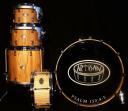Archive for July, 2007
Jeremy Horn “Atmosphere”
 Used with permission, these songs are from Jeremy Horn’s new release “Atmosphere”, in stores August 2007. Jeremy is a contemporary Christian artist/ worship leader. These tracks feature the Ash drum set shown.
Used with permission, these songs are from Jeremy Horn’s new release “Atmosphere”, in stores August 2007. Jeremy is a contemporary Christian artist/ worship leader. These tracks feature the Ash drum set shown.  This kit is used routinely in recording studios in the Memphis area. “Atmosphere” recorderd at The Grove studio, Memphis, TN.
This kit is used routinely in recording studios in the Memphis area. “Atmosphere” recorderd at The Grove studio, Memphis, TN.
Tuning Drums
I have come across a lot of buddies in the business of drumming who seem to struggle to get a good sound from their drums. In most cases, it is not the quality of the drum, or even the heads being used. It is the approach to putting the heads on and subsequent tuning.
I always start with the bottom head since this is really what produces the first note that you hear when the drum is first struck. If you think about it, at the exact moment of impact, the top head is actually muted by the stick. I seat the head evenly by finger tightening all the tension rods. Then I do 1/2 turns on all going around the drum like a clock. I don’t generally do a criss-cross pattern except maybe after the drum is in the ballpark. I am just careful to allow the head to tension slowly and as evenly as I can. Once in the region of the pitch I am after, then I begin tapping at each lug about 1″ in from the edge to check that all tension rods are tuned to one another. I repeat the same process for the top head and then lower it by about 1/2 a step pitch-wise. I like a little “bend” in the pitch of the drum.
That’s what I do and so far it has worked. There are times, however, when I just seem to be having a bad day and can’t get the sound out of the drum I am after. Of course, now that I make drums, I work all those bugs out of them so they don’t have that problem. lol
The Artisan
2 commentsSolid wood vs. plywood
In the interest of clarifying a common question among our customers, I am going to attempt to explain, in brief, the difference between solid wood shells (such as stave design) and ply wood shells (such as those made by the big guys). First, it is a known fact that plywood is very strong and it is used for that reason. It is also, by comparison, much less expensive than hardwood of any kind practically speaking. However, it’s application in the furniture world is limited- in fact your less expensive furniture is usually a composite board such as MDF, or plywood, with a pretty veneer over top simulating real wood. High end furniture, however, and certainly the kind that is made by master crafstmen is made from solid timber. And it has an appeal and quality about it that is unparalleled.
Ply drums are easiest to make, most economical, and very strong- unless they are too thin. All the glue used makes up a large portion of the total mass. Consequently, there is not a lot of natural shell vibration going on. Solid wood, on the other hand, is very resonant by itself. And, interestingly, the different densities within each species offers a different fundamental pitch to that wood- assuming all pieces are of the exact same dimensions. Consequently, solid wood shells have a more natural singing voice than ply, especially when they are tunedto the note they want to sing in! (the natural note of the shell) A simple illustration of this is evidenced in a marimba. Guess what? Solid wood!! And a definite pitch, right?
Some have expressed the concern of strength in a solid shell(stave) vs. ply. Most tables in high end furniture are edge glued and present no problems when done correctly. Stave drum shells are also edge glued, some even use a tongue and groove joint, though not necessary if done correctly. The staves themselves are very narrow (2-3″ in our case) and pose no danger of going out of round. In fact, a steam bent shell with re-inforcement rings has a far greater chance of going out of round. The shell has been forceably bent(unnatural process). Even plies are forceably bent, though easy to do because they are very thin. Still unnatural, however. Stave design imposes no stress at all, and the grain orientation in our drums are vertical which we also believe enhances the drums sensitivity.
Hope this helps everyone.
The Artisan
No commentsMuch debated issue
Hi! I am debating with friends about the way drum shells should be made: solid wood or laminated. I read your articles and it seems that you are manufacturing shells from solid (being french, “stave” translates as ”bar”, in other words “solid lug”).
I have access to CNC lathes and milling machines (with big size capacity). It’s my belief that drums shells could be produced from solid wood lugs, machined to tight tolerances, to obtain maximum resonnance. My buddies pretend that solid wood is not adequate, since the shells would crack and deform.
What is your opinion?
Thanks!
2 commentsWelcome to the Artisan Drumworks BLOG!
Hi, I’m The Artisan and I want to welcome you to our new website. Please feel free to discuss issues of importance and ask questions. We can all learn from one another, so thankyou for your post(s)! Artisan… from one craftsman to another.
No comments

